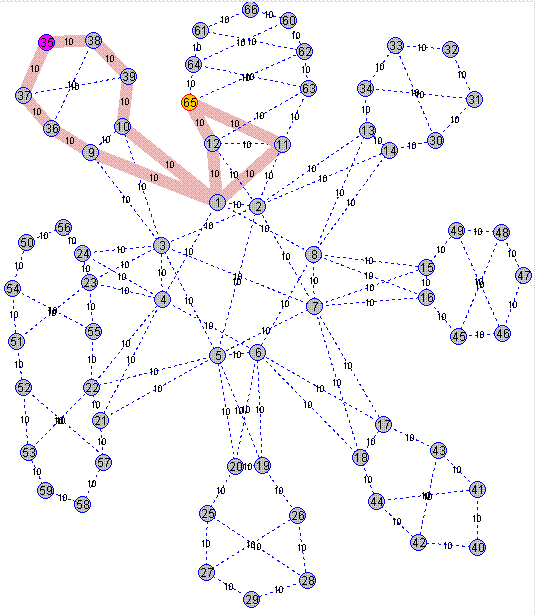Equal-cost multi-path routing on:
[Wikipedia]
[Google]
[Amazon]
 Equal-cost multi-path routing (ECMP) is a
Equal-cost multi-path routing (ECMP) is a
Etutorials: Equal-Cost Multi-Path (ECMP) Routing
Paris-Traceroute: traceroute for ECMP networks
Dublin-Traceroute: NAT-aware traceroute for ECMP networks
Traffic Engineering With Equal-Cost-MultiPath: An Algorithmic Perspective
{{DEFAULTSORT:Equal-Cost Multi-Path routing Routing algorithms
 Equal-cost multi-path routing (ECMP) is a
Equal-cost multi-path routing (ECMP) is a routing
Routing is the process of selecting a path for traffic in a network or between or across multiple networks. Broadly, routing is performed in many types of networks, including circuit-switched networks, such as the public switched telephone netw ...
strategy where packet forwarding
Packet forwarding is the relaying of packets from one network segment to another by nodes in a computer network. The network layer in the OSI model is responsible for packet forwarding.
Models
The simplest forwarding modelunicastinginvolves ...
to a single destination can occur over multiple best paths with equal routing priority. Multi-path routing can be used in conjunction with most routing protocols because it is a per-hop local decision made independently at each router. It can substantially increase bandwidth by load-balancing traffic over multiple paths; however, there may be significant problems in deploying it in practice.
History
Load balancing by per-packetmultipath routing
Multipath routing is a routing technique simultaneously using multiple alternative paths through a network. This can yield a variety of benefits such as fault tolerance, increased bandwidth, and improved security.
Mobile networks
To improve pe ...
was generally disfavored due to the impact of rapidly changing latency, packet reordering
In computer networking, out-of-order delivery is the delivery of packet (information technology), data packets in a different order from which they were sent. Out-of-order delivery can be caused by packets following multiple paths through a netwo ...
and maximum transmission unit
In computer networking, the maximum transmission unit (MTU) is the size of the largest protocol data unit (PDU) that can be communicated in a single network layer transaction. The MTU relates to, but is not identical to the maximum frame size that ...
(MTU) differences within a network flow, which could disrupt the operation of many Internet protocols, most notably TCP and path MTU discovery
Path MTU Discovery (PMTUD) is a standardized technique in computer networking for determining the maximum transmission unit (MTU) size on the network path between two Internet Protocol (IP) hosts, usually with the goal of avoiding IP fragmentati ...
. RFC 2992 analyzed one particular multipath routing strategy involving the assignment of flows through hashing
Hash, hashes, hash mark, or hashing may refer to:
Substances
* Hash (food), a coarse mixture of ingredients
* Hash, a nickname for hashish, a cannabis product
Hash mark
*Hash mark (sports), a marking on hockey rinks and gridiron football field ...
flow-related data in the packet header
In information technology, header refers to supplemental data placed at the beginning of a block of data being stored or transmitted. In data transmission, the data following the header is sometimes called the ''payload'' or ''body''.
It is vital ...
. This solution is designed to avoid these problems by sending all packets from any particular network flow through the same path while balancing multiple flows over multiple paths in general.
See also
*Link aggregation
In computer networking, link aggregation is the combining ( aggregating) of multiple network connections in parallel by any of several methods, in order to increase throughput beyond what a single connection could sustain, to provide redundan ...
* Shortest Path Bridgingestablishes multiple forward and reverse paths on Ethernet
Ethernet () is a family of wired computer networking technologies commonly used in local area networks (LAN), metropolitan area networks (MAN) and wide area networks (WAN). It was commercially introduced in 1980 and first standardized in 198 ...
networks.
* Source routing
In computer networking, source routing, also called path addressing, allows a sender of a packet to partially or completely specify the route the packet takes through the network. In contrast, in conventional routing, routers in the network determ ...
* TRILL
TRILL (Transparent Interconnection of Lots of Links) is an Internet Standard implemented by devices called TRILL switches. TRILL combines techniques from bridging and routing, and is the application of link-state routing to the VLAN-aware custom ...
enables per flow pair-wise load splitting without configuration and user intervention.
References
External links
Etutorials: Equal-Cost Multi-Path (ECMP) Routing
Paris-Traceroute: traceroute for ECMP networks
Dublin-Traceroute: NAT-aware traceroute for ECMP networks
Traffic Engineering With Equal-Cost-MultiPath: An Algorithmic Perspective
{{DEFAULTSORT:Equal-Cost Multi-Path routing Routing algorithms